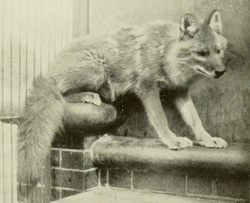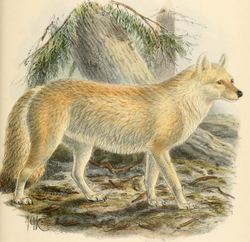Biology:Tien Shan dhole
| Tian Shan dhole | |
|---|---|

| |
| Photographed by William Percival Westell (1910) | |
| Scientific classification | |
| Domain: | Eukaryota |
| Kingdom: | Animalia |
| Phylum: | Chordata |
| Class: | Mammalia |
| Order: | Carnivora |
| Family: | Canidae |
| Genus: | Cuon |
| Species: | |
| Subspecies: | C. a. hesperius
|
| Trinomial name | |
| Cuon alpinus hesperius Afanasjev and Zolotarev, 1935[1]
| |
| Synonyms | |
|
Cuon alpinus jason (Pocock, 1936) | |
The Tian Shan dhole (Cuon alpinus hesperius), also known as the Siberian dhole, Western Asiatic dhole,[2] or northern dhole is a subspecies of dhole native to the Altai and Tian Shan mountain ranges, and possibly Pamir and Kashmir.
Characteristic
The Tian Shan dhole is somewhat smaller than the Ussuri dhole, with a relatively wider skull and much lighter, straw-coloured winter fur coat. It has a short, wide face and a skull measuring 180 mm long on average. The top of the head and outer sides of the ears are reddish-straw coloured. The upper surface of the neck is dirty-white, with a narrow, sandy-yellow-coloured band running along the upper surface of the back from the ears to the shoulders. The outer surfaces of the limbs are sandy-yellow, while the flanks and inner sides of the limbs have little to no yellowish tint.[3]
The auditory bullae of this subspecies has distinct morphology compared to other dhole subspecies.[4]
Distribution and habitat

The Tian Shan dhole's habitats consists of mountain ranges and other areas with colder climate. It currently lives in the Tian Shan and the Altai Mountains.
The dhole was once widespread from Northeast to southern Central Asia in Transoxiana. They formerly lived in Siberia, Mongolia, Kazakhstan, Kyrgyzstan and Turkmenistan. The Tian Shan dhole still occurs in Tibet. A few still live in the Gansu Province from northwestern China. Although dholes have not been recorded in Pakistan , they once occurred in the alpine steppes extending into Kashmir.
Hunting and diet
It feeds primarily on Siberian ibexes, arkhar, argali, roe deer, maral and wild boar, as well as musk deer and reindeer.[5]
References
- ↑ Wozencraft, W.C. (2005). "Order Carnivora". in Wilson, D.E.; Reeder, D.M. Mammal Species of the World: A Taxonomic and Geographic Reference (3rd ed.). Johns Hopkins University Press. ISBN 978-0-8018-8221-0. OCLC 62265494. http://www.departments.bucknell.edu/biology/resources/msw3/browse.asp?id=14000795.
- ↑ Fox, M. W. (1984), The Whistling Hunters: Field Studies of the Indian Wild Dog (Cuon Alpinus), Steven Simpson Books, p. 40, ISBN:0-9524390-6-9
- ↑ Heptner & Naumov (1998). Mammals of the Soviet Union. p. 579. https://archive.org/stream/mammalsofsov211998gept#page/580/mode/2up.
- ↑ "Dhole | Canids". https://www.canids.org/species/view/PREKQW171301.
- ↑ Heptner, V. G. & Naumov, N. P. (1998), Mammals of the Soviet Union Vol.II Part 1a, SIRENIA AND CARNIVORA (Sea cows; Wolves and Bears), Science Publishers, Inc. USA., pp. 566-86, ISBN:1-886106-81-9
Wikidata ☰ Q19840927 entry
 |


